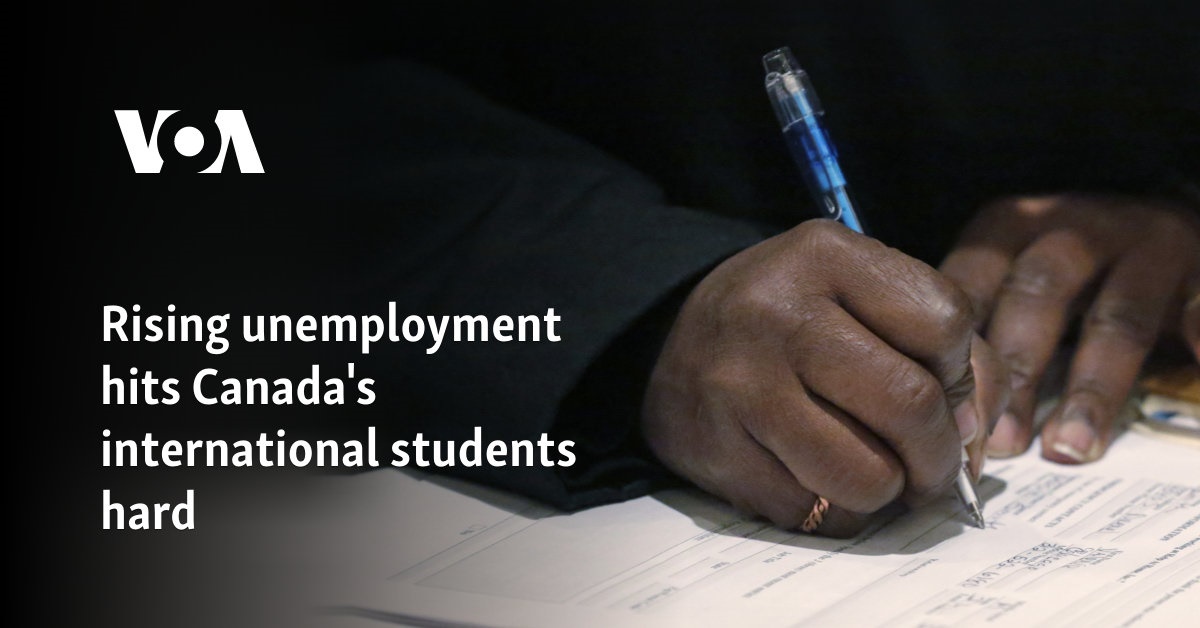Jobs
Rising unemployment hits Canada’s international students hard

A tightening job market in Canada, fueled by a surge of immigration that produced the fastest population growth in 67 years, is hitting the country’s large cohort of international students particularly hard.
With more than 1 million foreign students in the country who are largely restricted to low-wage, part-time jobs, photos are being shared on social media of long lines forming outside businesses with even a single job opening for a position such as cashier.
“The present affordability crisis in Vancouver, along with the declining job opportunities, is becoming very stressful,” said Dhvani Malik, a fourth-year international relations student at the University of British Columbia.
“International students already pay so much in fees, and the increasing rent and living costs have only added to the financial pressure,” Malik told VOA. “In my circle, students are taking multiple part-time jobs to address this burden. … Students have to make the bargain of getting certain groceries at some point and then leaving the rest for when they can afford it.”
Youth unemployment hovers near 12%
Unemployment in Canada has been inching up in recent months, hitting 6.1% in March and roughly twice that for young people, according to the federal government’s statistical agency. The trend is attributed in part to rapid population growth, fueled almost entirely by immigration and the arrival of temporary residents such as seasonal workers and foreign students.
In public remarks this month, Prime Minister Justin Trudeau effectively acknowledged that his government’s strategy of addressing a severe labor shortage by opening the door to record numbers of immigrants and temporary residents has overshot the mark.
“To give an example, in 2017, 2% of Canada’s population was made up of temporary immigrants,” Trudeau was quoted by Global News as saying during a housing announcement in Dartmouth, Nova Scotia. “Now we’re at 7.5% of our population comprised of temporary immigrants. That’s something we need to get back under control.”
Statistics Canada reported that the country’s population of about 39 million grew last year at its fastest rate since 1957, with immigration accounting for almost all the growth. But while helping address a post-pandemic labor shortage, the rapid increase has placed pressure on housing costs and government-financed health care.
“We want to get those numbers down,” Trudeau was quoted as saying in Nova Scotia. “It’s a responsible approach to immigration that continues on our permanent residents, as we have, but also hold the line a little more on the temporary immigration that has caused so much pressure in our communities.”
International students, who are offered pathways to employment in Canada and eventual citizenship after graduation, have been an important part of the rapid growth. Canada has roughly the same number of foreign students as the United States with eight times the population, The Washington Post reported this week.
Regulations restrict work hours
Because the foreign students pay much higher fees than Canadian citizens, they are also an important source of revenue for the nation’s universities. However, facing mounting political pressure, the government in January announced new caps on the number of foreign students that would be admitted, and last month announced a plan to scale back the total number of temporary residents.
For foreign students seeking to support themselves in Canada while pursuing their degrees, the problem is exacerbated by regulations that restrict the kinds of jobs they can accept and the number of hours they can work.
“The main issue is that they cannot work full time,” said Al Parsai, an immigration expert based in Toronto. “They also do not have a Canadian degree or Canadian work experience, yet. Consequently, they end up looking for hourly minimum wage jobs.”
Malik, the UBC student, said she finds herself shut out of many job opportunities because she cannot provide a referral from a prior employer or relative in Canada.
“My field has several job opportunities in the nonprofit sector and the government, but those jobs are reserved for domestic students and refugees,” she said.
“I have celiac disease, and the groceries are already so expensive that with the current crisis, it is becoming unaffordable to get through my grocery list,” she said. “In a nutshell, the current crisis is making it difficult to stay in Canada.”
The decision to cut back student visas, meanwhile, is expected to create financial headaches for universities such as UBC, one of the most prestigious in Canada, where tuition-paying international students accounted for 27% of the school’s enrollment in 2022.
The harshest province to crack down on international students has so far been Ontario, which has aimed to give 96% of its foreign study permits only to public universities and colleges, shutting out private colleges that have been criticized as “diploma mills.”
Quebec might go even further, as the Parti Quebecois has asked the provincial government to freeze all temporary immigration to Canada.










